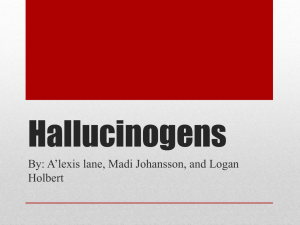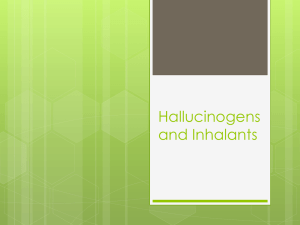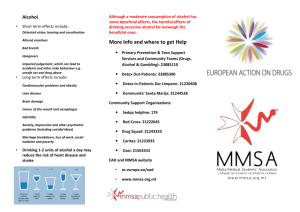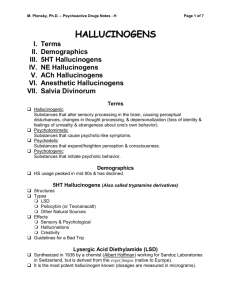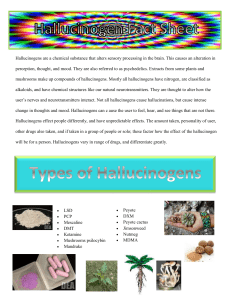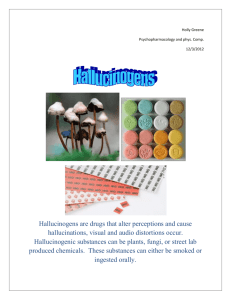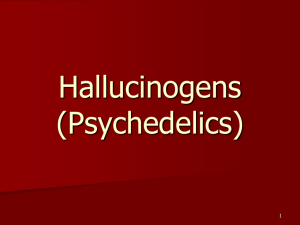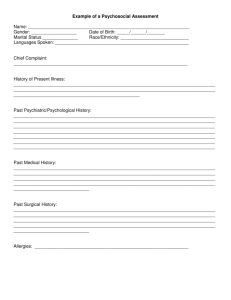Fact Sheet on Hallucinogens
advertisement
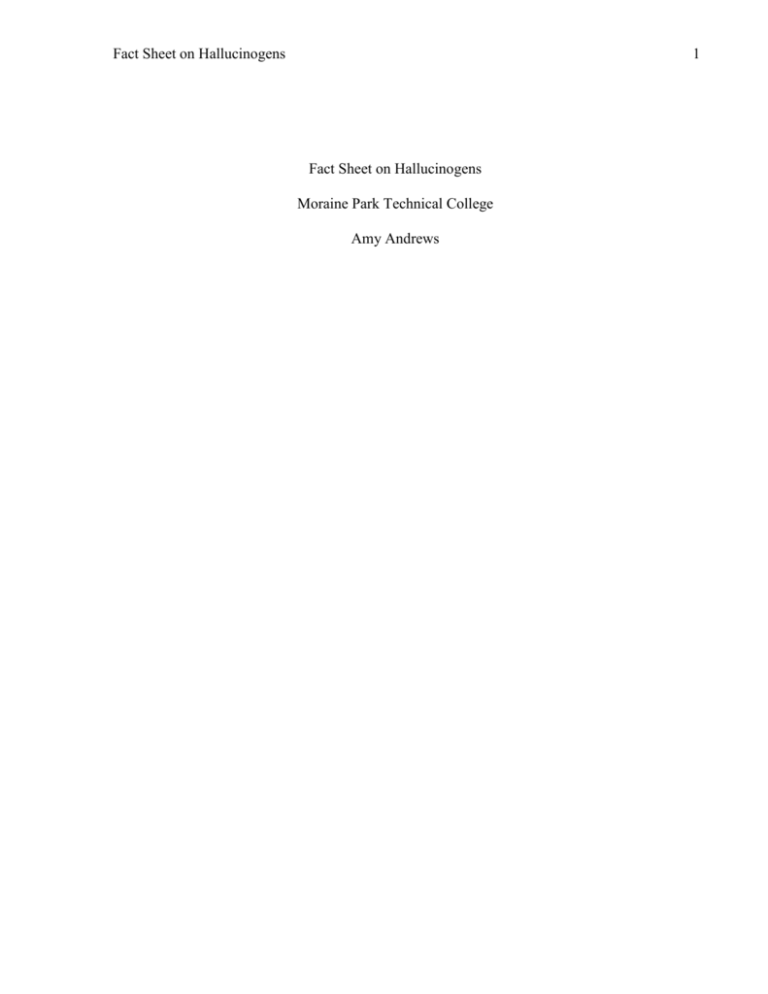
Fact Sheet on Hallucinogens 1 Fact Sheet on Hallucinogens Moraine Park Technical College Amy Andrews Fact Sheet on Hallucinogens Hallucinogens- The general group of pharmacological agents can be divided into three broad categories: psychedelics, dissociatives, and deliriants. These classes of psychoactive drugs have in common that they can cause subjective changes in perception, thought, emotion and consciousness. Unlike other psychoactive drugs, such as stimulants and opioids, these drugs do not merely amplify familiar states of mind, but rather induce experiences that are qualitatively different from those of ordinary consciousness. These experiences are often compared to non-ordinary forms of consciousness such as trance, meditation, and dreams. (Hanson, Venturelli, & Fleckenstein, 2009) Types of HallucinogensPsychedelics: Are a psychoactive drug whose primary action is to alter cognition and perception. Examples are LSD, Psilocybin, Mescaline Dissociatives: Are a class of psychoactive drugs which are said to reduce or block signals to the conscious mind from other parts of the brain. Examples are PCP, Ketemine, DXM Deliriants: Plants as deadly nightshade, mandrake, henbane and datura. Also antihistamines diphenhydramine (Benadryl), its close relative dimenhydrinate (Dramamine or Gravol) and hydroxyzine. Street Names for Various Hallucinogens LSD is known as acid, trips, microdots, dots, blotters, mellow or tabs may be named according to the design on the blotting paper e.g. a picture of a yellow star would attract the name, “yellow stars” Mushrooms can be called their common botanical names, magic mushrooms, shrooms, magics, blue meanies, liberty caps, golden tops, mushies PCP: angel dust, peace pill Ketamine: Special K, K, ket, kitkat, super K (“Hallucinogens,”) 2 Fact Sheet on Hallucinogens Neurological (brain) Effects of Hallucinogen Abuse- The effects that hallucinogenic drugs have on the brain are quite complicated and very interesting. Many users of hallucinogenic drugs have experienced whole personality changes which raises questions about the relationship between brain and behavior. Scientists began to carefully study the serotonin system and found out that hallucinogens do in fact have some kind of effect on serotonin. Hallucinogenic drugs cause an increase in the level of brain serotonin, but they inhibit the rapid firing of neurons containing serotonin. This is a negative feedback system in which as the serotonin level rises, the activity of serotonergic neurons decreases. It was originally theorized that this effect of hallucinogenic drugs directly caused sense alteration and hallucinations. Several observations however have shown this theory not to be true. These observations include the following: Low doses of LSD effect behavior, but do not depress firing of serotonergic neurons, The behavioral effects of LSD outlast the alteration of the firing of the serotonergic neurons, Repeated dosage of LSD results in a decrease of behavioral changes, but still effects neuron firing, Other hallucinogens do not affect serotonergic neurons, When serotonin levels are depleted, the effectiveness of LSD is not eliminated. It has now been determined that the effects of hallucinogenic drugs are actually caused by the effects that hallucinogenic drugs have on the post-synaptic activity of serotonergic neurons. Hallucinogenic drugs directly affect the serotonin receptors(specifically the serotonin receptor subtype, 5-HT2), which is what eventually results in a complex pattern of action potentials and activity. This was 3 Fact Sheet on Hallucinogens proven by the fact that the depletion of serotonin levels in animals does not result in a decrease of behavioral effects caused by hallucinogenic drugs. ("The effects of," ) Physiological Effects from Hallucinogen Abuse- Hallucinogenic drugs cause both physical and psychological effects on humans. The physical effects of these drugs include: dilated pupils, elevated body temperature, increased heart rate and blood pressure, appetite loss, sleeplessness, tremors, headaches, nausea, sweating, heart palpitations, blurring of vision, memory loss, trembling, and itching. A user of hallucinogenic drugs will also experience a number of psychological alterations in the brain. These drugs may cause hallucinations and illusions as well, as the amplification of sense, and the alterations of thinking and self-awareness. It is quite possible to have a bad reaction to hallucinogenic drugs. This is referred to as a "bad trip" and may cause panic, confusion, suspicion, anxiety, and loss of control. The long-term effects of these drugs can be quite dangerous. These long-term effects may include: flashbacks, mood swings, impaired thinking, unexpected outbursts of violence and eventually possibly depression that may lead to death or suicide. ("The effects of," ) Psychedelic Effects of Hallucinogen Abuse- Create a range of perceptual distortions and various psychological symptoms. Under the influence of hallucinogens, the senses seem to be enhanced, and brilliant hallucinations occur. Many users experience synesthesia, in which various forms of hallucinations occur simultaneously. Many also describe feeling disconnected from their bodies or other altered states of reality. Short and Long Term Health Risks of the Abuse of Hallucinogens- 4 Fact Sheet on Hallucinogens Increased rapid heart beat Higher blood pressure Agitation Increased body temperature and sweating may lead to chills Bad hallucinations Panic attacks Anxiety Paranoia Flashbacks after use Dizziness Impaired coordination Nausea and vomiting Long Term Side Effects Flashbacks Are the most common long term effects associated with hallucinogens Are moments where the effects of the drug are experienced and this can occur years after use They can last for a few minutes and can either be pleasant or uneasy They are usually visual perhaps involving colors and hallucinations Long term use of hallucinogens could impair memory and other brain functions Personality and mood changes in people have occurred Drug-induced psychosis involving hallucinations and delusional behaviour can occur, lasting up to several hours. (“Hallucinogens,”) Signs and Symptoms of Hallucinogen Abuse- Extremely dilated pupils, warm skin, excessive perspiration, and body odor are symptoms. Distorted sense of sight, hearing, touch; distorted image of self and time perception, mood and behavior changes, the extent depending on emotional state of the user and environmental conditions. Unpredictable flashback episodes even long after withdrawal (although these are rare). Hallucinogenic drugs, which occur both naturally and in synthetic form, distort or disturb sensory input, sometimes to a great degree. Hallucinogens occur naturally in primarily two forms, (peyote) cactus and psilocybin mushrooms. Several chemical 5 Fact Sheet on Hallucinogens varieties have been synthesized, most notably LSD, MDA, STP, and PCP. Hallucinogen usage reached a peak in the United States in the late 1960s, but declined shortly thereafter due to a broader awareness of the detrimental effects of usage. However, a disturbing trend indicating resurgence in hallucinogen usage by high school and college students nationwide has been acknowledged by law enforcement. With the exception of PCP, all hallucinogens seem to share common effects of use. Any portion of sensory perceptions may be altered to varying degrees. Synesthesia, or the “seeing” of sounds,and the “hearing” of colors, is a common side effect of hallucinogen use. Depersonalization, acute anxiety, and acute depression resulting in suicide have also been noted as a result of hallucinogen use. 6 Fact Sheet on Hallucinogens 7 Resources Hanson, G, Venturelli, P, & Fleckenstein, A. (2009). Drugs and society. Sudbury MA: Jones and Bartlett Publishers, LLC. Hallucinogens. [Web]. Retrieved from http://www.ceida.net.au/hallucinogens/ The effects of hallucinogenic drugs on the brain. [Web]. Retrieved from http://serendip.brynmawr.edu/exchange/node/1880
